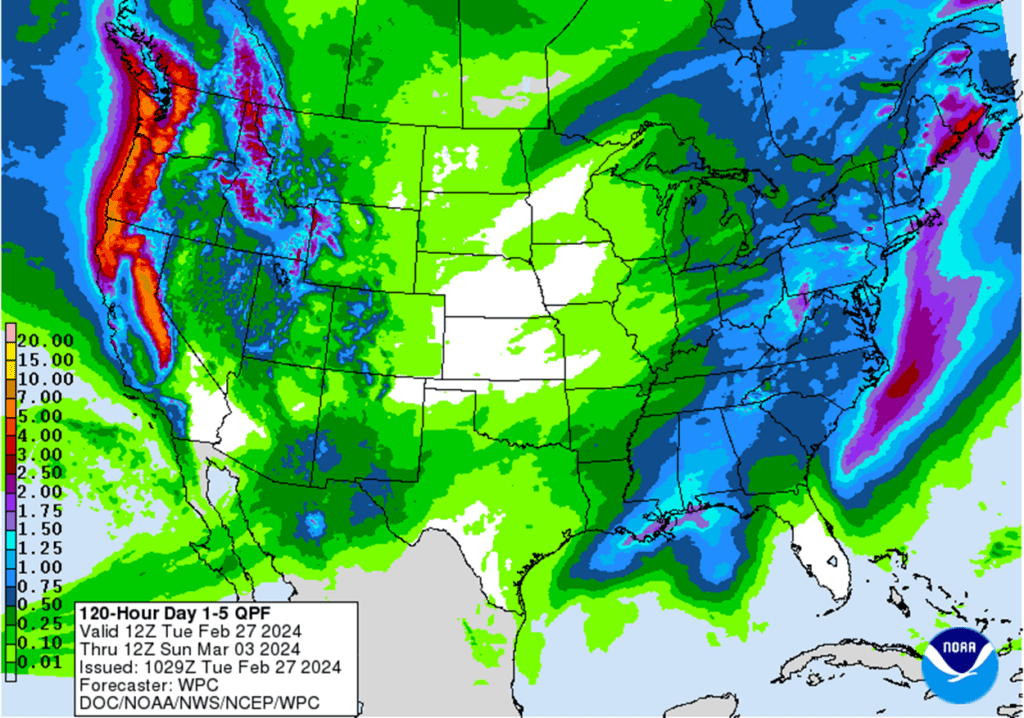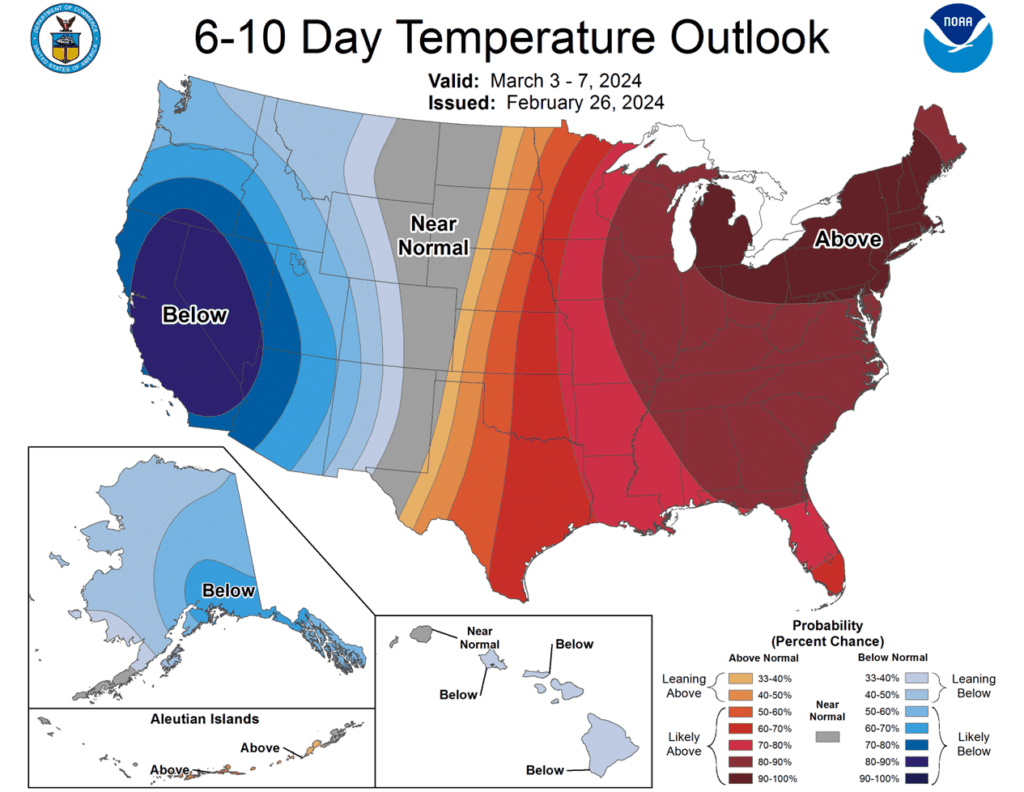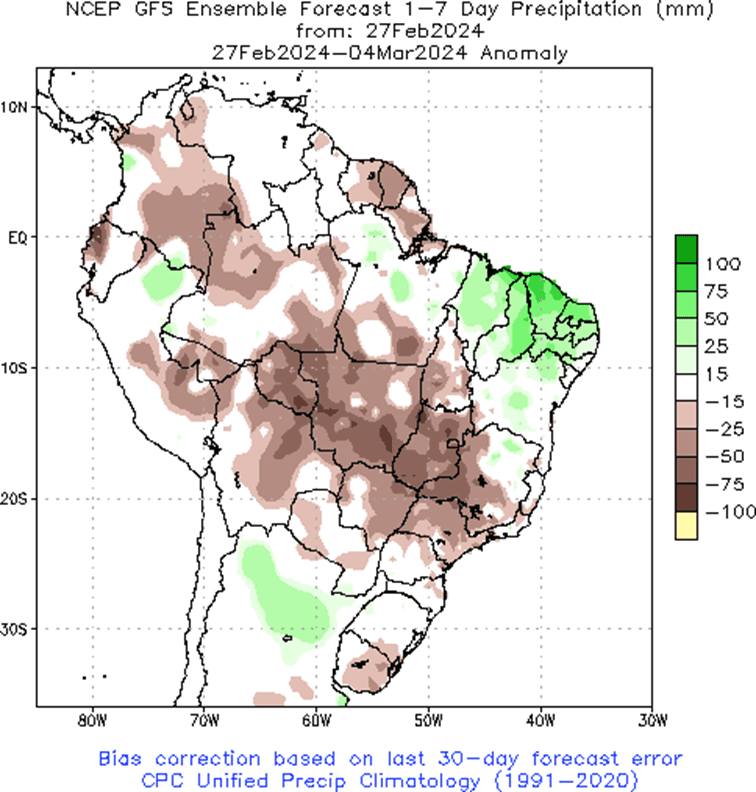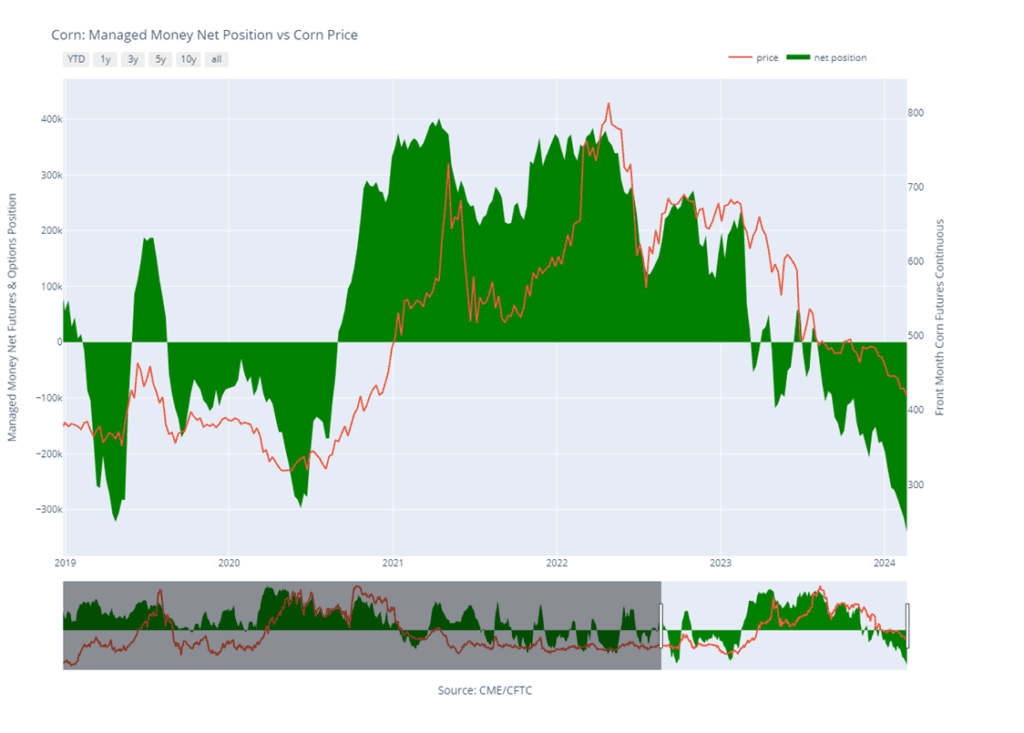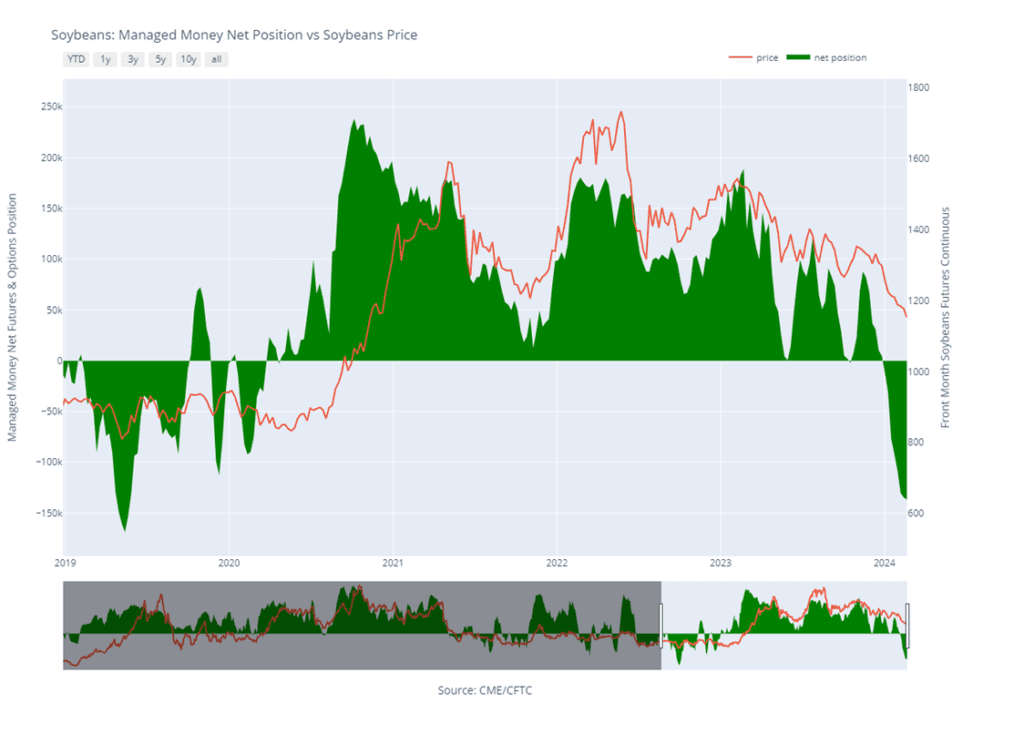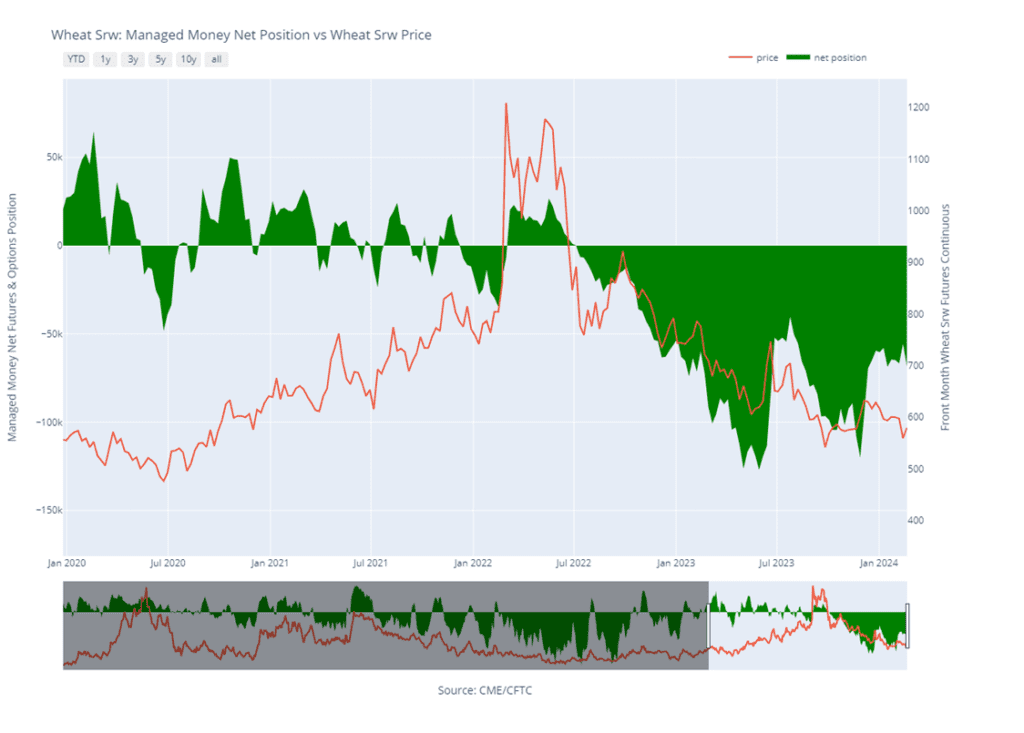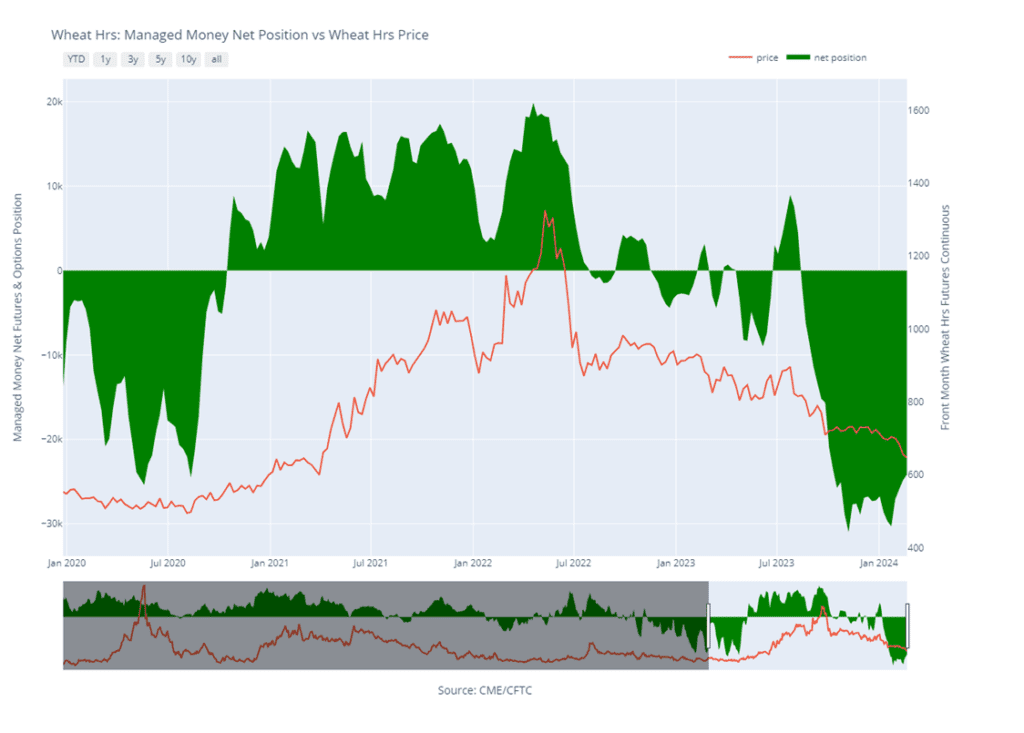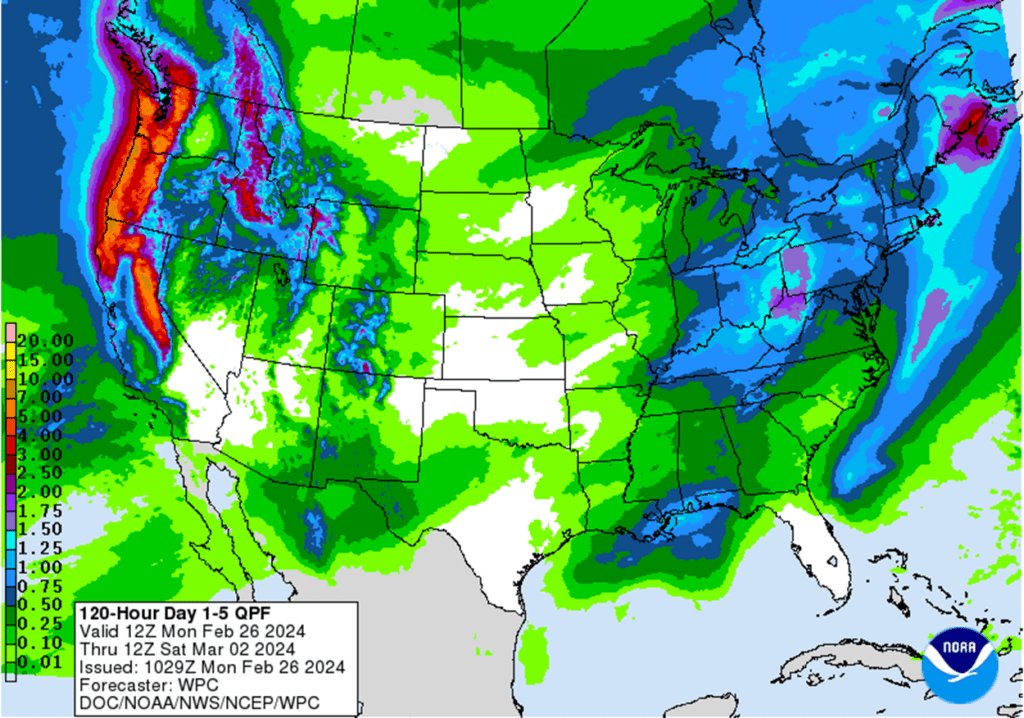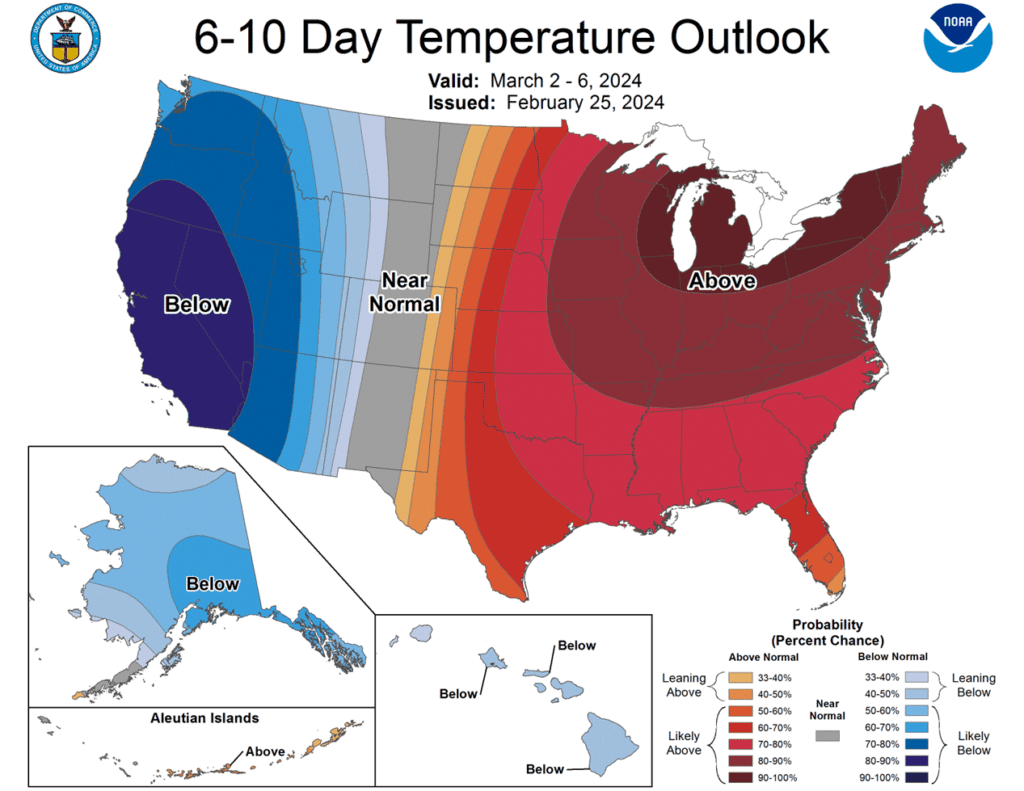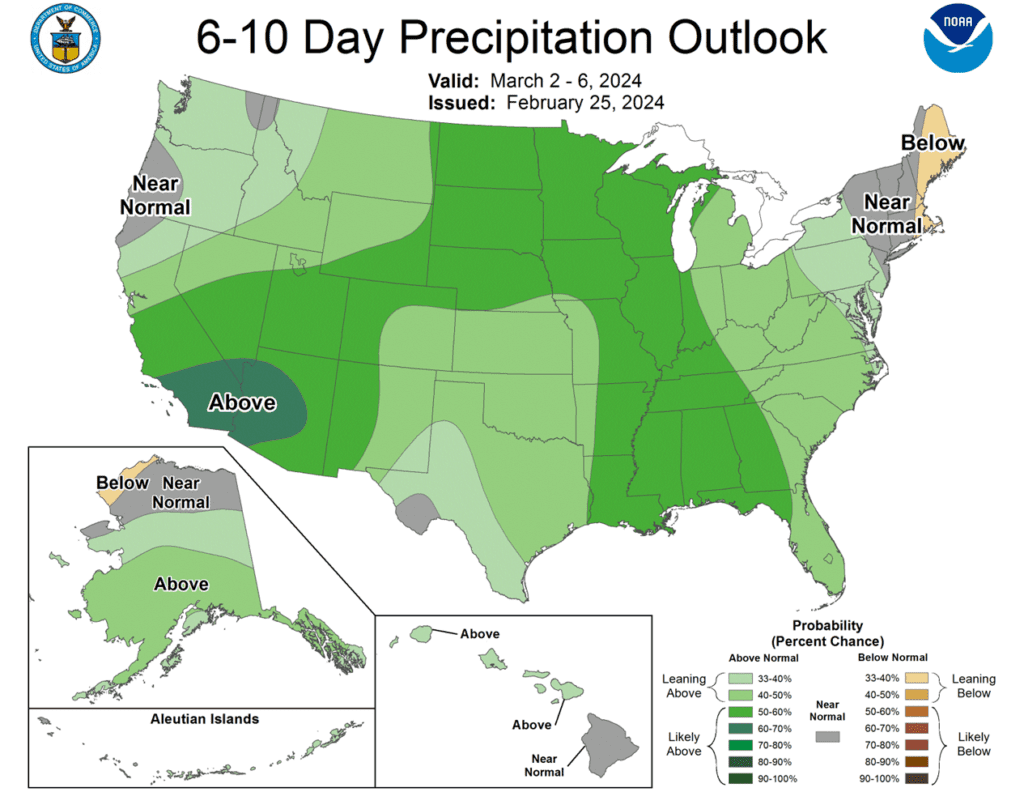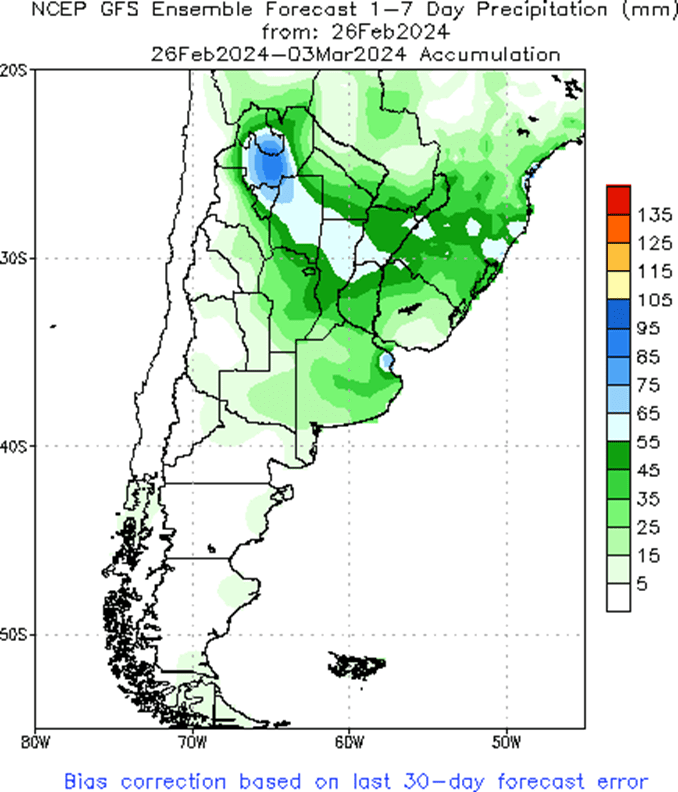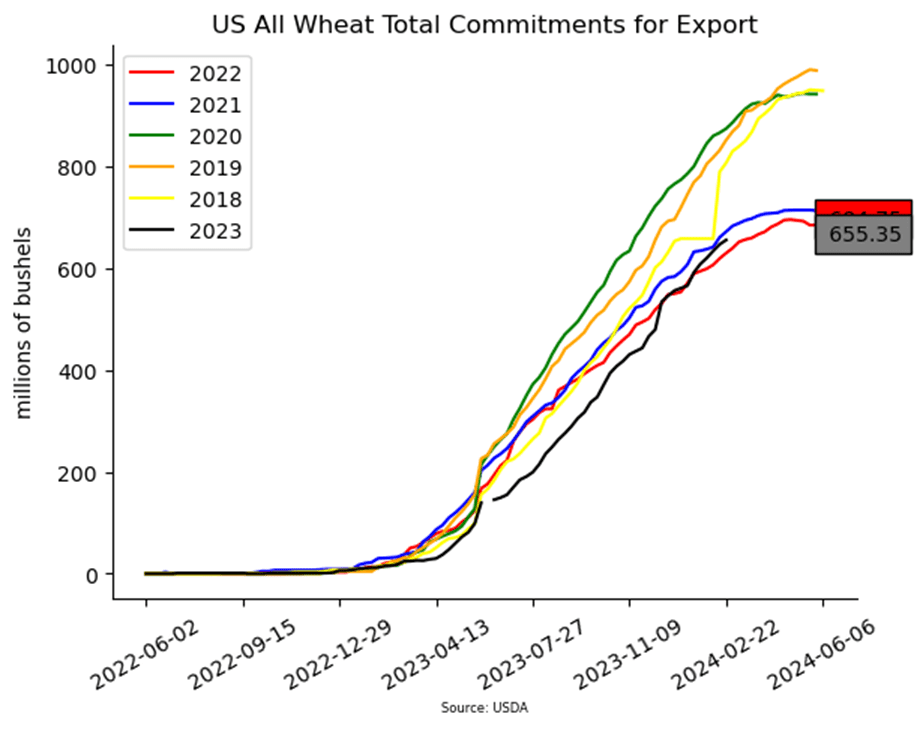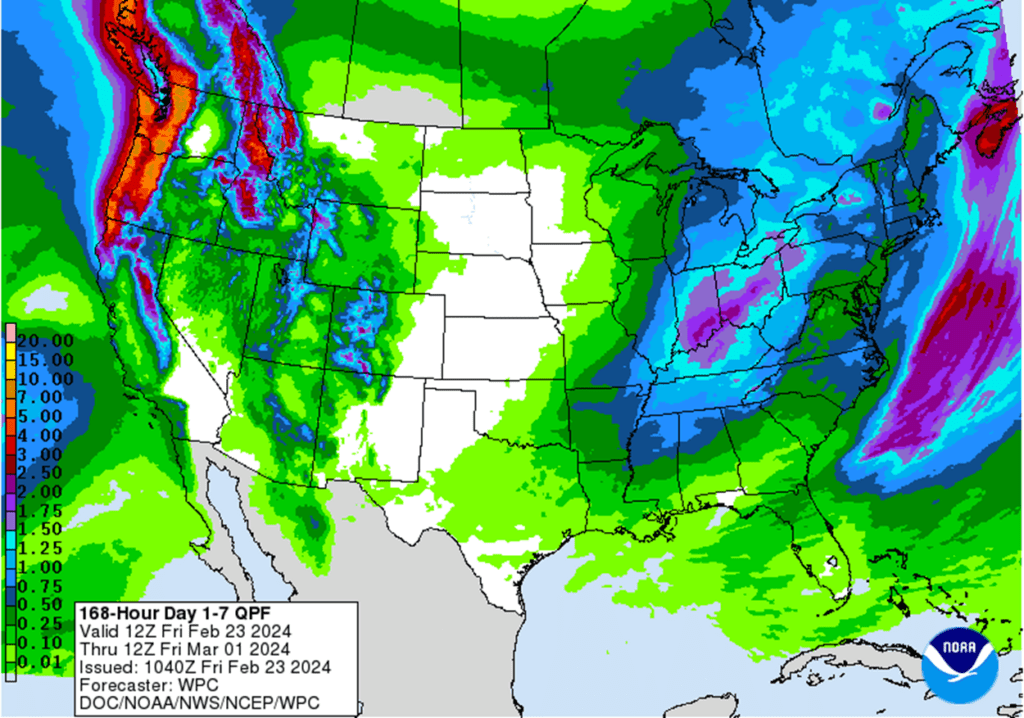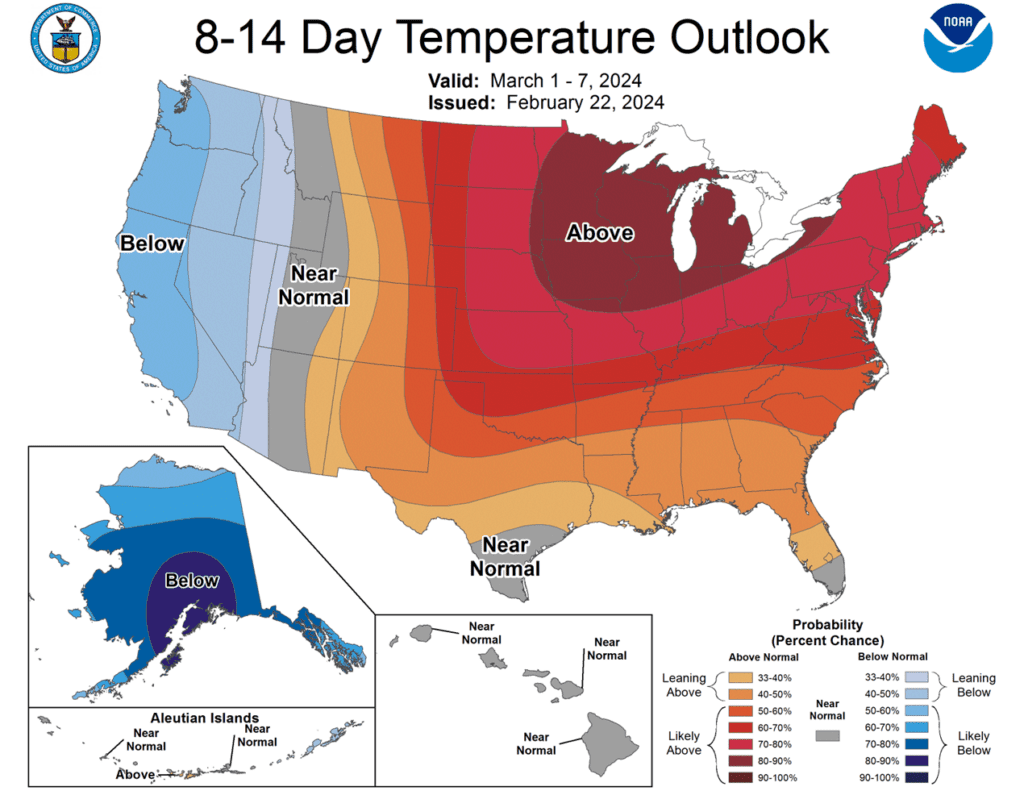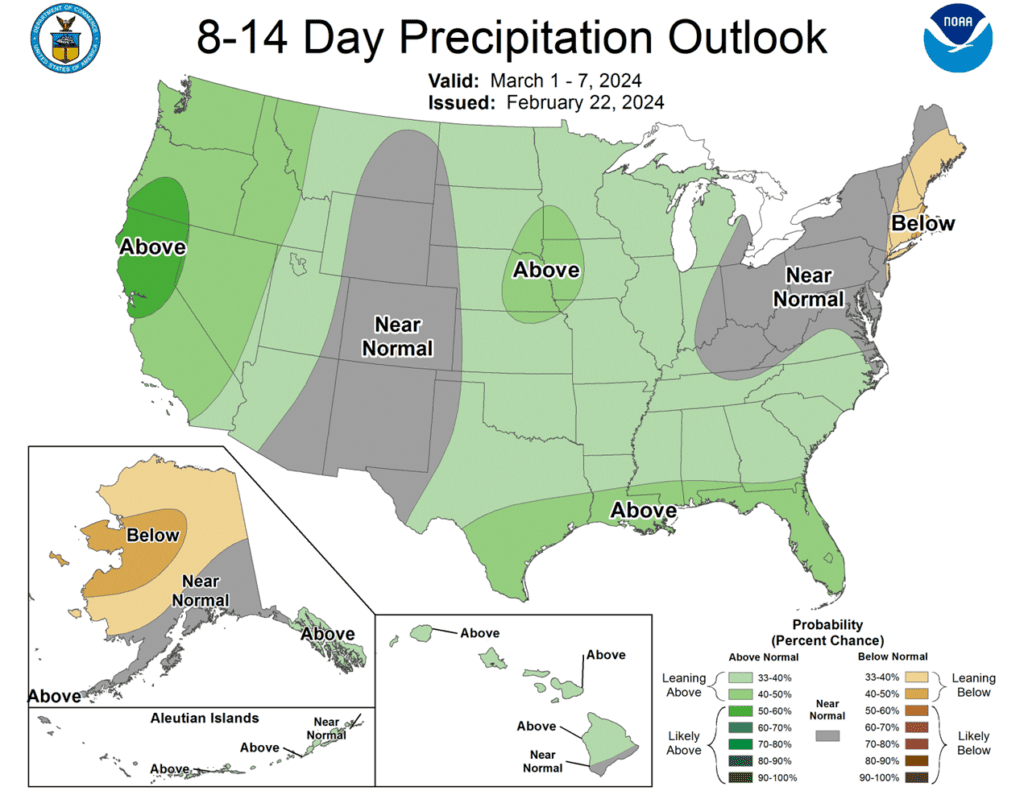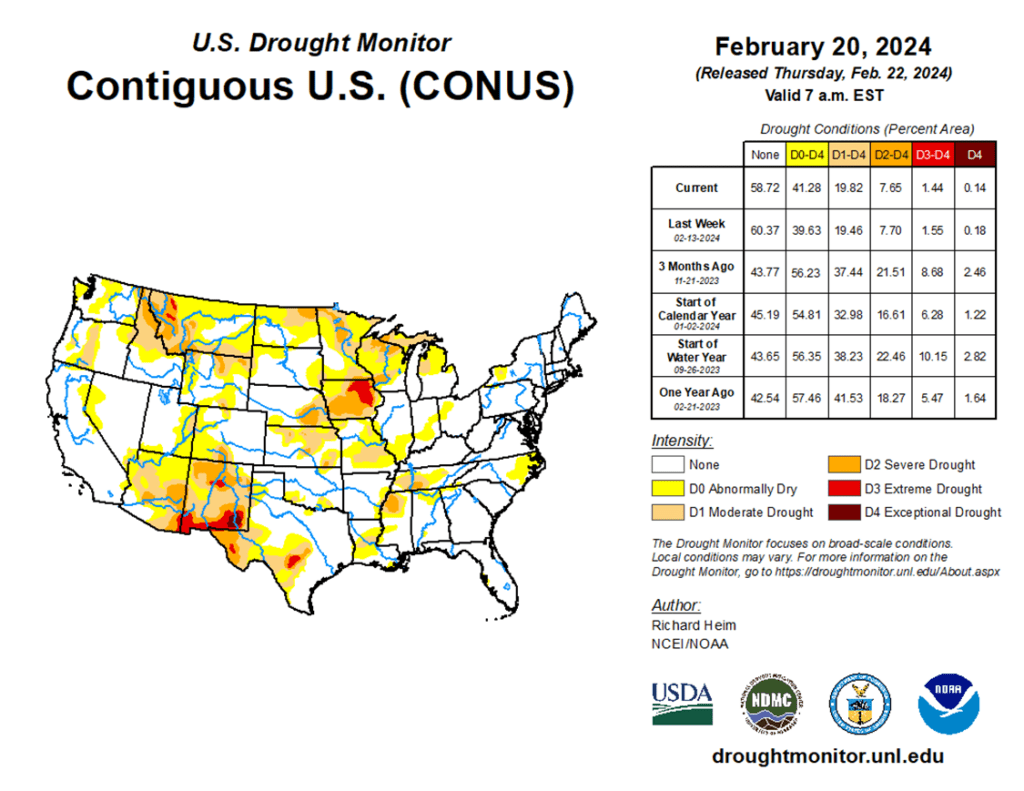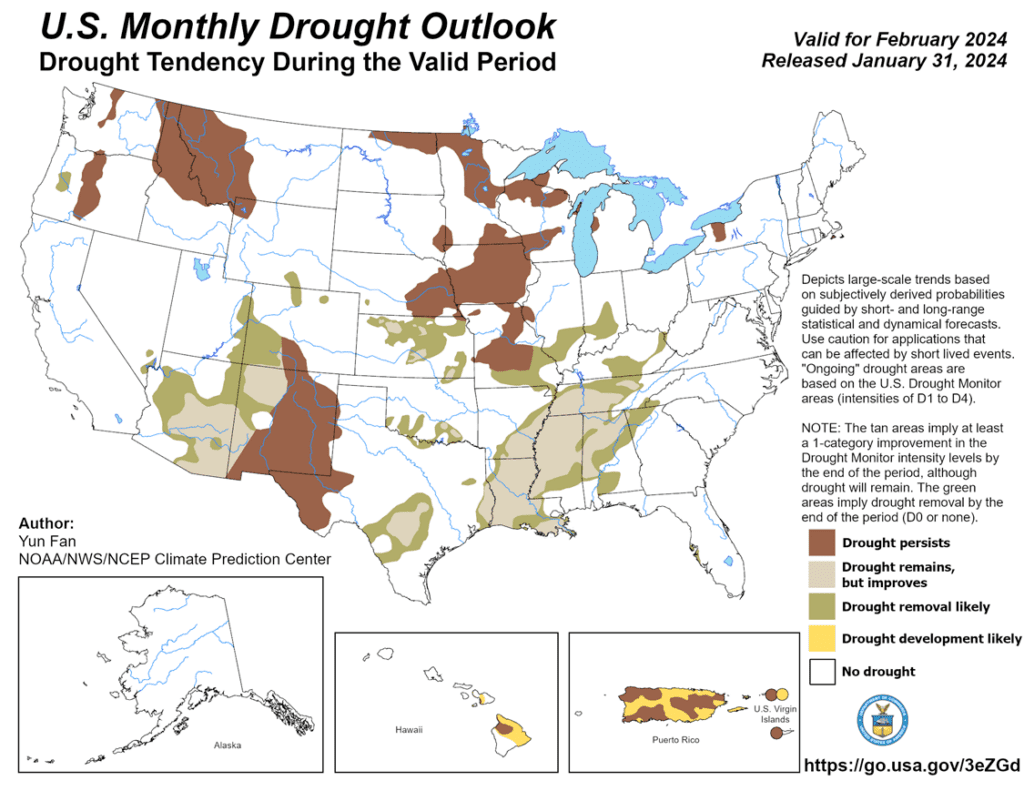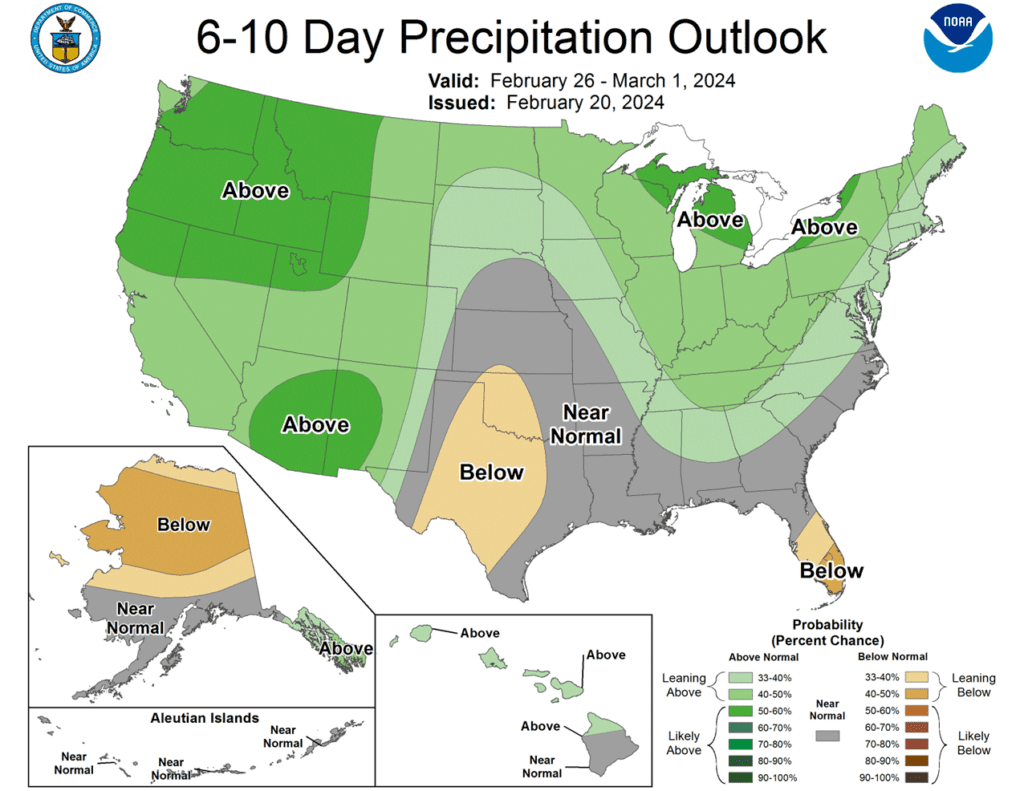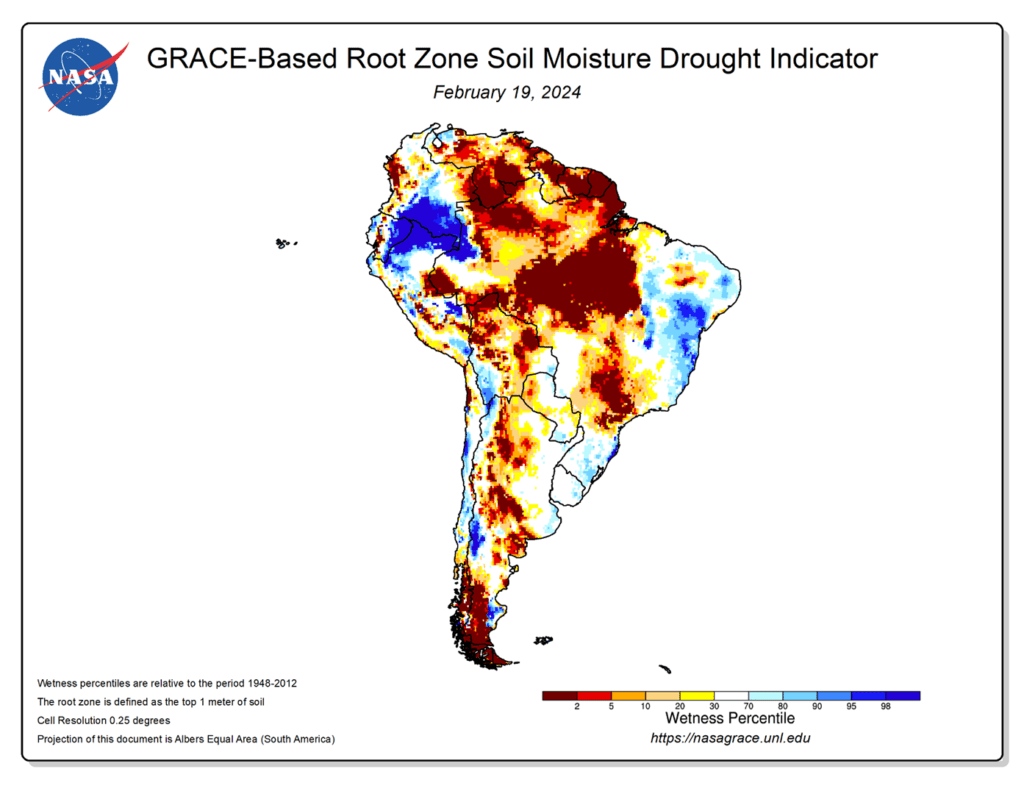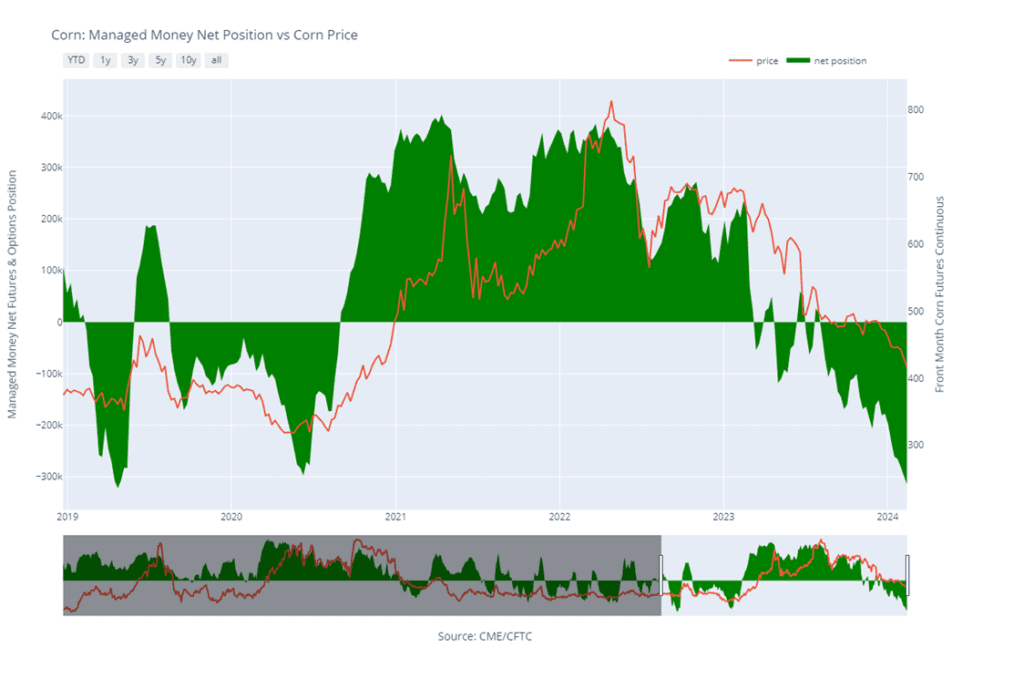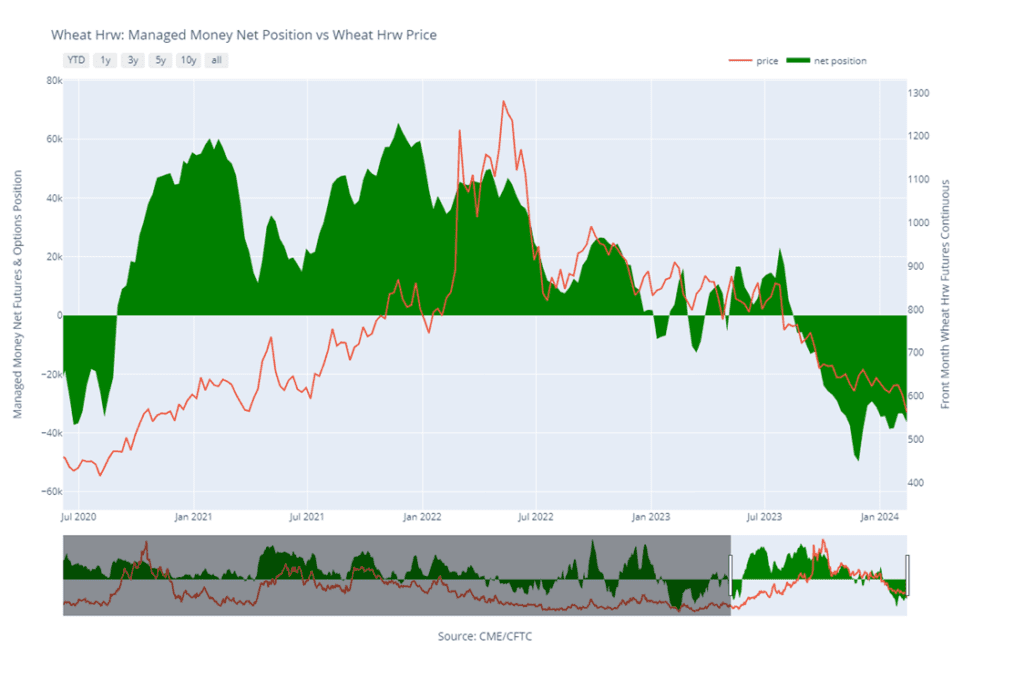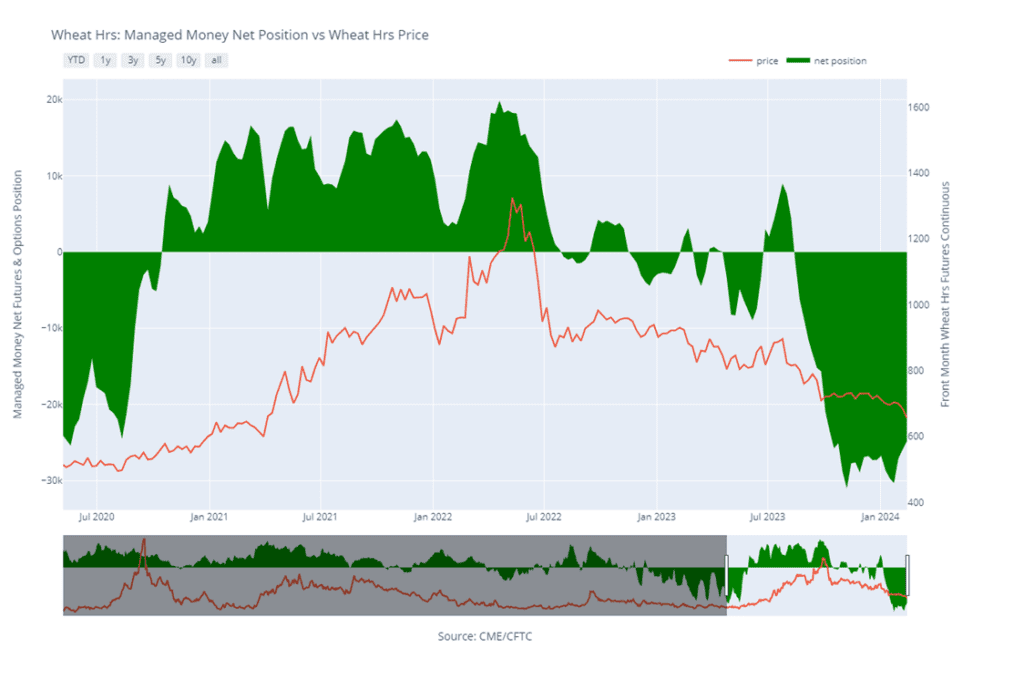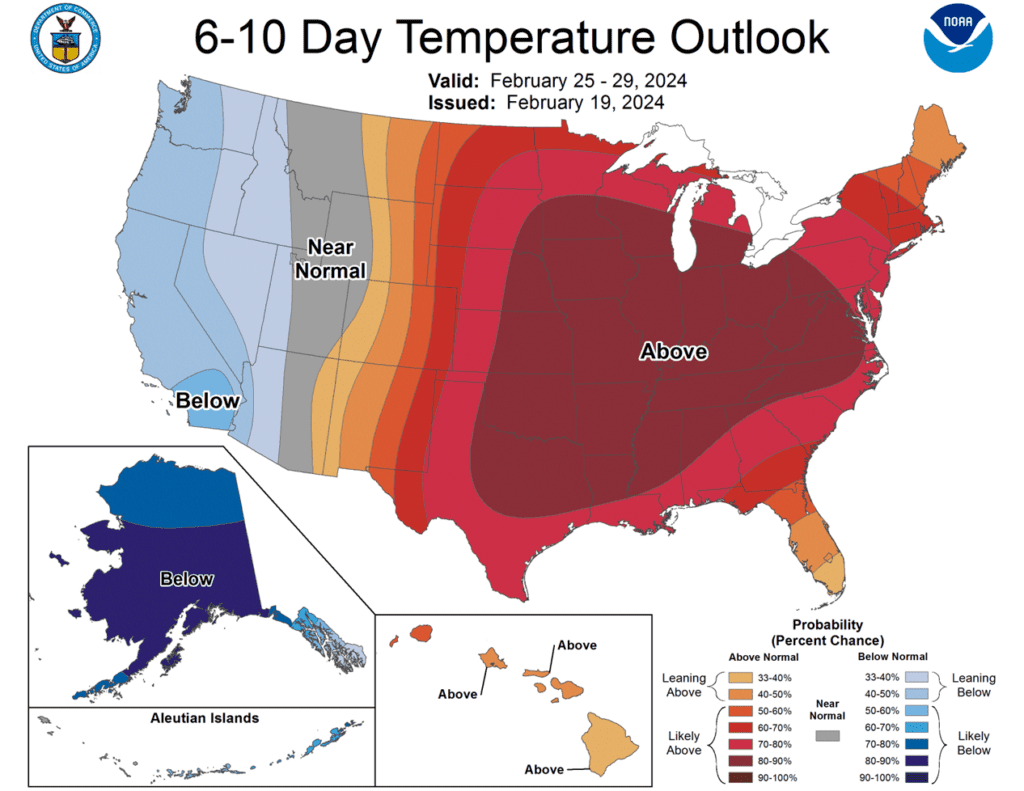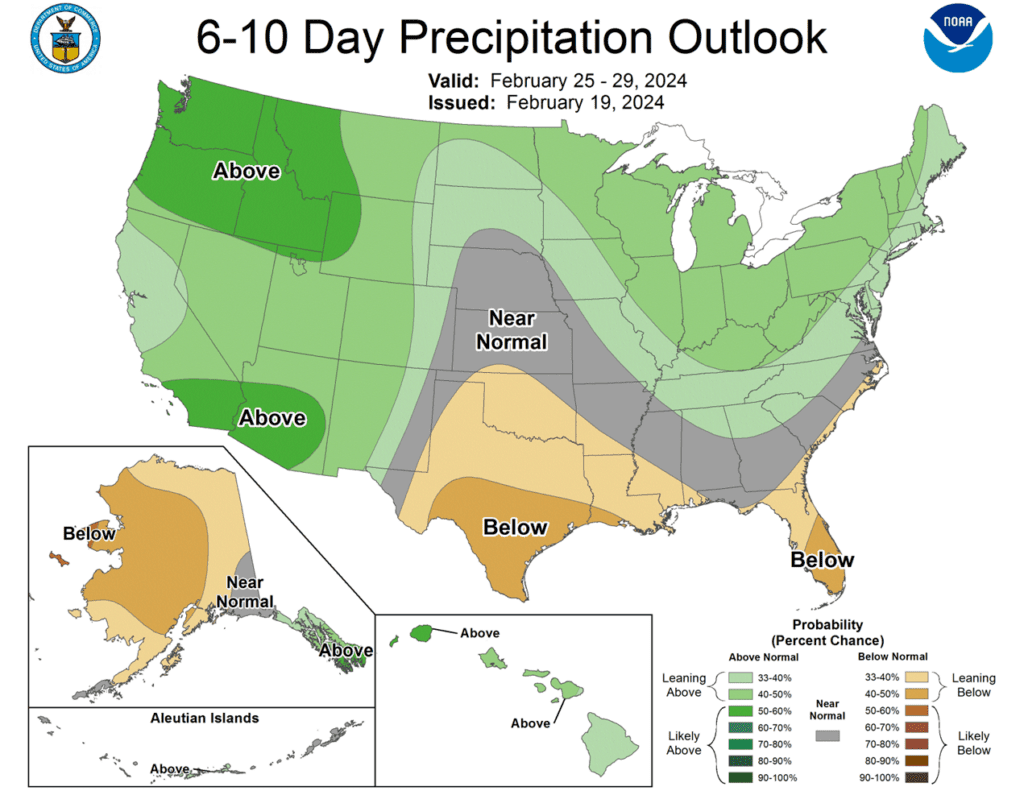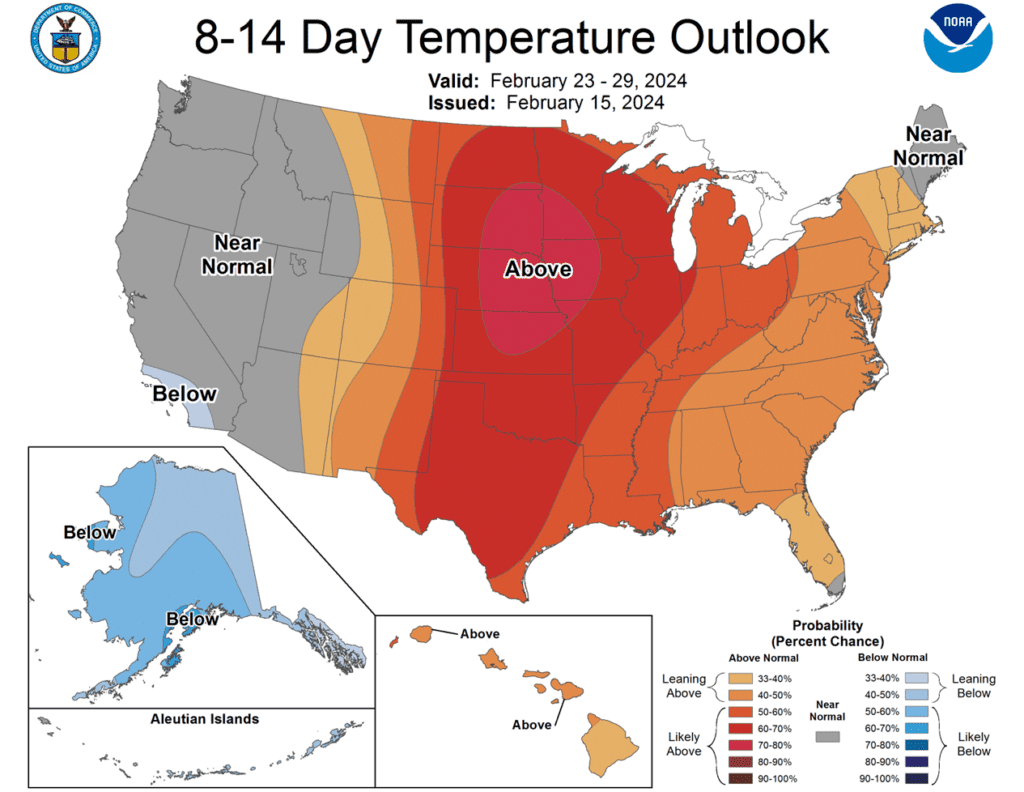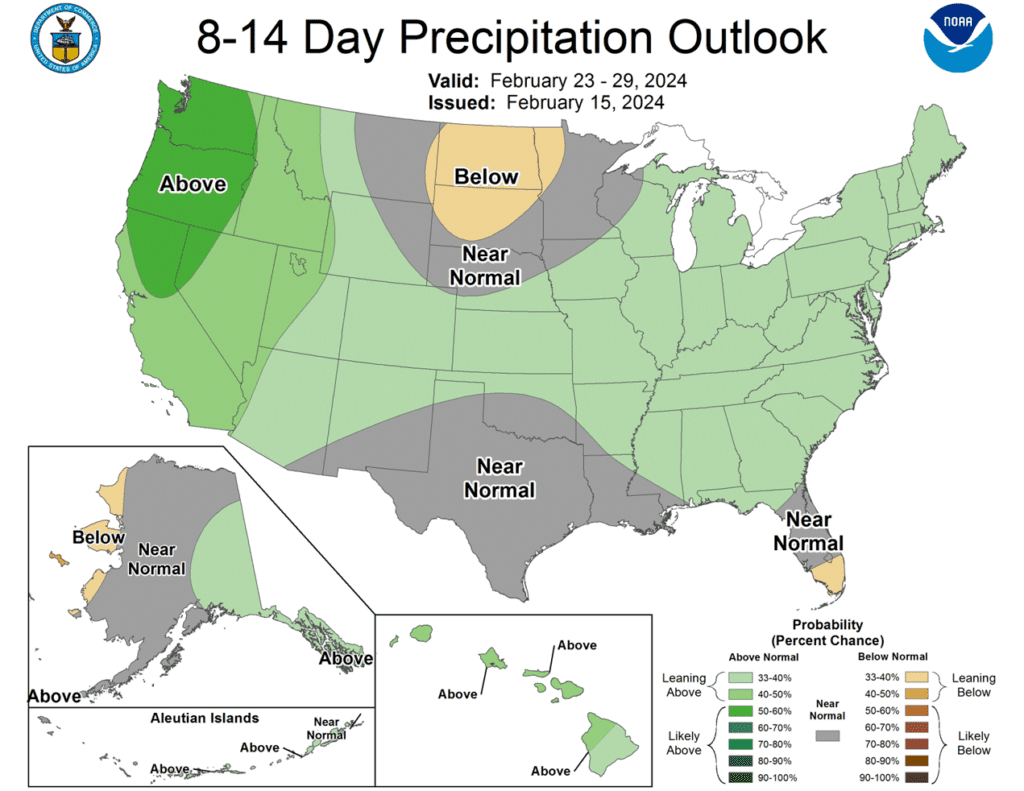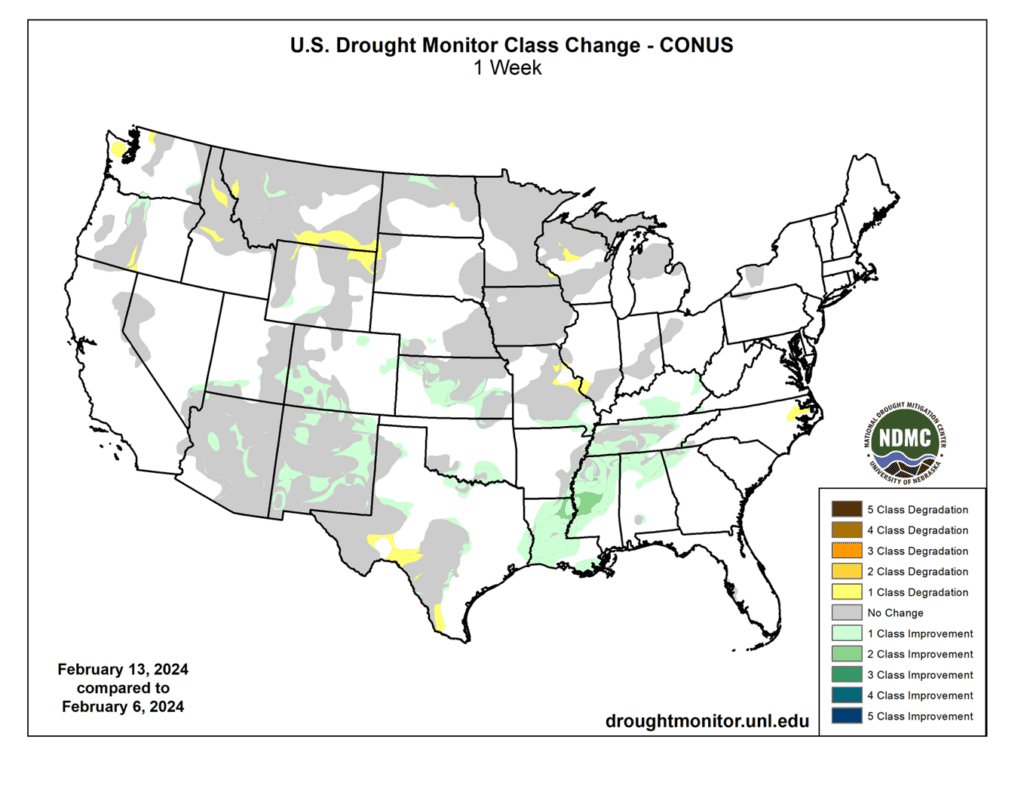2-29 End of Day: Grain Markets Settle Mostly Higher on Thursday
All prices as of 2:00 pm Central Time
Grain Market Highlights
- Garnering support from higher wheat, the corn market settled slightly higher and well off its lows from earlier in the session. The lack of deliveries in the March contract supported prices as traders continued to roll their short March positions to the deferred contracts.
- Higher than expected deliveries against the March contract added a layer of resistance to the soybean market, which like corn, traded on both sides of unchanged before settling lower on the day. Weekly export sales also came in at the low end of expectations with nearly 400 metric tons cancelled from unknown destinations.
- Both soybean meal and oil settled in the green, with bean oil mostly near unchanged, while meal gained $2 in the March and $1.70 in the May. Strong meal sales added support as they are currently running 22% ahead of last year.
- The wheat complex settled mostly higher on the day with the March contracts gaining on the deferreds as traders look to roll existing short March positions to other delivery months.
- To see the updated US Drought Monitor and 6 – 10 day temperature and precipitation outlooks, and the 2-week precipitation forecast, as a percent of normal, for Brazil courtesy of the NWS, CPC, NOAA, and the NDMC, scroll down to the other Charts/Weather section.
Note – For the best viewing experience, some Grain Market Insider content is best viewed with your phone held horizontally.
Corn
Corn Action Plan Summary
- No new action is recommended for 2023 corn. With a general lack of bullish news and an estimated US carryout nearing 2.2 billion bushels, front month corn has languished in a sideways to lower trend since printing a high last October. While the lack of a bullish catalyst has been disappointing, the market is in a significantly oversold condition, and managed funds continue to hold a substantial net short position. Either or both could trigger a short covering rally at any time heading into the spring planting window. As planting nears, and uncertainties increase, Grain Market Insider will consider recommending additional sales if prices recover back toward the 500 level.
- No new action is recommended for 2024 corn. In January, Dec ’24 broke through the bottom end of the 485 ¾ to 602 range that had been in place since February ’22. While this was a disappointing development, bear spreading has allowed Dec ’24 to maintain more of its value versus old crop as traders attempt to price in a larger 2023 carryout with more uncertainty ahead for the 2024 crop. Additionally, Dec ’24 is significantly oversold on the weekly chart, which is supportive for a technical rally to begin at any time as the spring planting window quickly approaches. Given the amount of time and uncertainty that remains for the 2024 crop, Grain Market Insider will consider recommending additional sales on a retracement toward the low to mid 500 level.
- No Action is currently recommended for 2025 corn. Grain Market Insider isn’t considering any recommendations at this time for the 2025 crop that will be planted next year. It will probably be late winter or early spring of 2024 before Grain Market Insider starts considering the first sales targets.
To date, Grain Market Insider has issued the following corn recommendations:
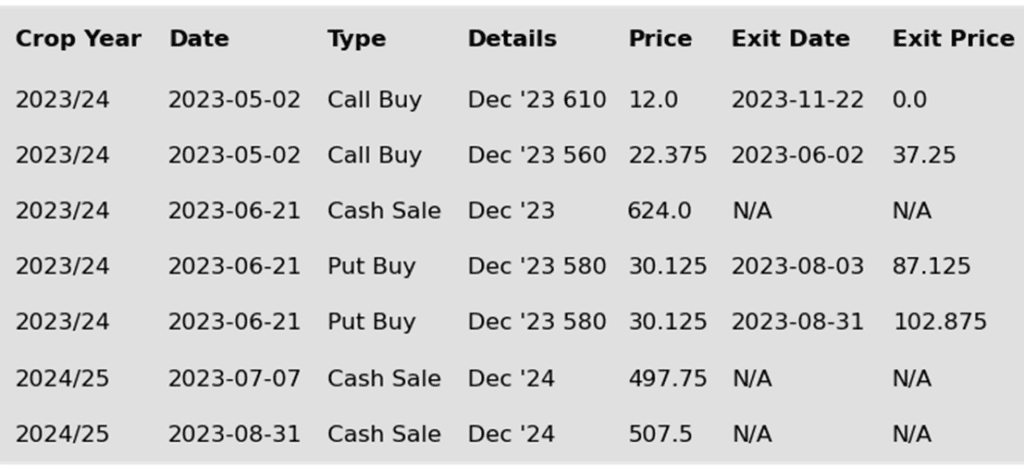
- Choppy two-sided trade dominated the corn market that saw both sides of unchanged but closed with only modest gains, but well off the lows, as bull spreading gave strength to the front months over the deferreds.
- This morning, the USDA reported export sales for the week ending February 22. Last week, corn export sales totaled 42.6 mb for 23/24 and 6.5 mb for 24/25, which were at the upper end of expectations, and puts total commitments 30% ahead of last year. Shipments last week totaled 47.9 mb and were above the 45.5 mb pace needed per week to reach the USDA’s export goal of 2.1 bb.
- Today was First Notice Day for deliveries on the March contracts, and there were no deliveries issued. This lent support to the March contract as short contract holders continue to roll positions to the May.
- Futures open interest has steadily fallen since last week with the number of open contracts down over 100,000 contracts from last Thursday. This, with the recent rally, implies that traders are liquidating some of their short positions. There is currently very little, if any, weather premium in the market, and as planting season nears, weather will become a more influential factor for both here and in Brazil.
- Current Brazilian weather is still considered non-threatening for crops, helping the key second crop Brazilian corn crop get off to a strong start. Moisture levels overall are still limited, so rainfall will need to stay timely as the crop develops.

Above: On February 26, the May corn contract posted a bullish reversal indicating support below the market rests just above 400 psychological support near 410. If this support level holds, the market may run into upward resistance between 435 and 450. If 400 support does not hold, further support should come in around 390.

Soybeans
Soybeans Action Plan Summary
- No new action is recommended for 2023 soybeans. Old crop soybeans continue to be in a downtrend that began with the early January breakout of the 1290 – 1400 range that had been in place since last fall. While South American weather has improved, questions remain regarding the crop size, and US planting season is now not that far off with its own potential concerns that could turn prices back higher. Given the potential of a downside breakout back in December, Grain Market Insider recommended adding to sales as prices remained historically good, and Grain Market Insider will continue to look at additional sales opportunities heading into spring.
- No new action is recommended for the 2024 crop. Since the beginning of the year, Nov ’24 has continued to recede alongside the 2023 old crop contracts as South American weather stabilized and the market deals with bourgeoning domestic supplies and slow demand. While this decline in prices is disappointing, planting season is not far off, and plenty of time remains to market this crop, with many unknowns that can rally prices yet ahead. Considering the amount of uncertainty that lies ahead with the 2024 soybean crop, Grain Market Insider recommended back in December buying Nov ’24 1280 and 1360 calls to give you confidence to make sales against anticipated production, and to protect any sales in an extended rally. Based on our research, the possibility remains that prices could retest the 2022 highs in the upper 1300s going into spring/summer, at which point Grain Market Insider would consider recommending additional sales.
- No Action is currently recommended for 2025 Soybeans. Grain Market Insider isn’t considering any recommendations at this time for the 2025 crop that will be planted next year, and it may be some time before conditions are conducive to consider making any recommendations. Be patient as we monitor the markets for signs of improvement.
To date, Grain Market Insider has issued the following soybean recommendations:

- Soybeans ended the day lower after another day of volatile trade. Prices were sharply lower earlier this morning following a large number of deliveries against the March contract. Export sales were at the low end of expectations and there were some cancellations. Interestingly, the front months in both soybean meal and oil closed higher.
- With First Notice Day today came a surprisingly large number of deliveries totaling 702 contracts against the March futures, which initially drove prices down before they rebounded slightly. There will likely be more deliveries tomorrow which could pressure the March contract even more against the May.
- Today’s Export Sales report showed an increase of just 5.9 mb of soybean export sales for 23/24. This was up from last week but down 30% from the prior 4-week average. Last week’s export shipments of 40.5 mb were well above the 18.2 mb needed to meet the USDA’s estimates. Primary destinations were to China, the Netherlands, and Mexico. There were cancellations of 392 mt of soybeans from unknown destinations.
- Next week the USDA will release its WASDE report and trade will look to see if adjustments are made to South America’s expected production. Argentina is expected to produce double what was produced in the drought last year, and Brazil was estimated to produce 156 mmt of soybeans in the USDA’s February update despite most other analysts estimating the number closer to 149 mmt.

Above: Front month soybeans appear to have rejected the bullish reversal from February 26. However, for now, initial support between 1133 and 1140 still holds. If prices can rally back and recover from being oversold, they may hit resistance between 1190 and 1205. Otherwise, if they decline further, major support below the market may enter in around 1040 – 1050.
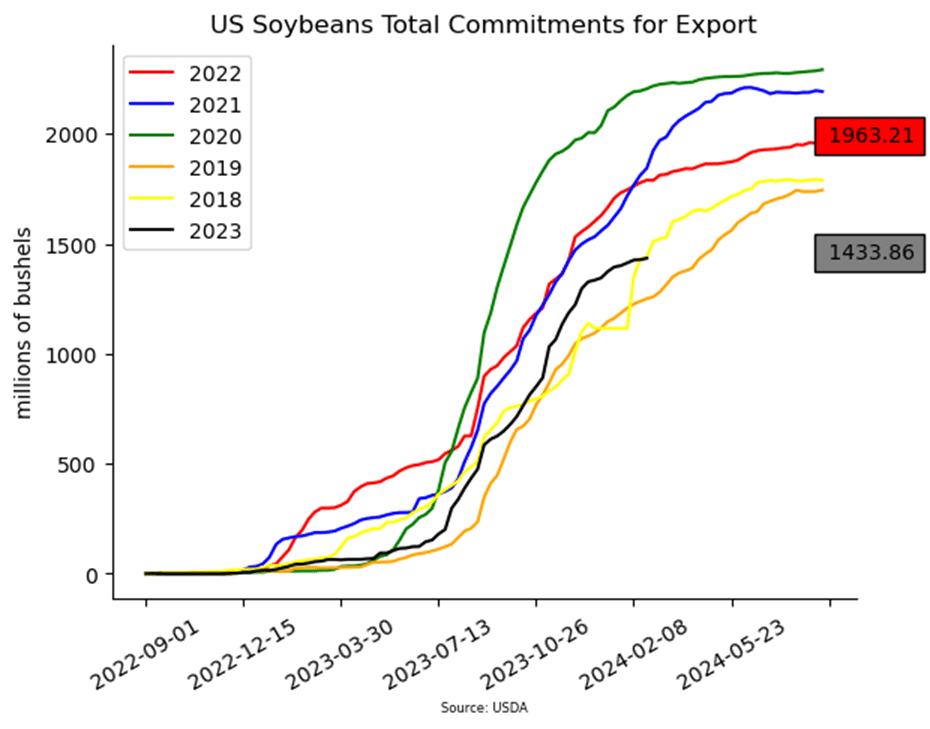
Wheat
Market Notes: Wheat
- After a two-sided trade wheat closed mostly higher; September Chicago wheat onward posted small losses. On the bearish side, there were 484 deliveries of Chicago wheat, which was more than anticipated. However, momentum on some technical indicators still point to the upside for wheat as it moves out of oversold territory.
- The USDA reported an increase of 12.0 mb of wheat export sales for 23/24 and a decrease of 0.2 mb for 24/25. Shipments last week at 19.8 mb were above the 17.9 mb pace needed per week to reach the USDA’s export goal of 725 mb.
- Argentina is set to receive abundant rain over the next several days that will fall over most of their agriculture producing areas. The southwestern areas will receive less precipitation, but it is still expected to benefit the corn and soybean crops. As it pertains to wheat, this should help recharge soil moisture before the upcoming planting.
- According to Russian Ag Minister, Dmitry Patrushev, Russia has no interest in renewing the Black Sea Grain Initiative. This deal between Russia and Ukraine ended last July, but Ukraine has been successful in exporting grain via their own corridor. It is estimated that combined Russian and Ukrainian grain exports for February were a record 6.5 mmt. Russian wheat FOB values also continue to fall, weighing on the export market.
- India is said to be preparing to purchase between 30 and 32 mmt of 23/24 wheat, according to their food ministry. For reference, the Indian government purchased 26 mmt of wheat from the 22/23 crop for its welfare programs versus a target of 34.2 mmt. Note – India is the world’s second largest wheat producer and is also the second largest consumer.
- The wildfires in Texas are said to have expanded to the second largest in state history. Residents living in the panhandle area were ordered to evacuate as schools and highways were shut down. This is the worst wildfire in nearly two decades. Texas is experiencing drought which only worsens the issue. It is unknown what impact this will have on the wheat crop at this time, but it is expected that there will be some damage.
Chicago Wheat Action Plan Summary
- No new action is currently recommended for 2023 Chicago wheat. The wheat market has continued to be dominated by lower world export prices that have stymied US export sales and depressed US prices. In early December, Grain Market Insider recommended taking advantage and making a sale on a short covering rally which was sparked by several Chinese purchases of US wheat. Since then, China has been silent in the US wheat export market, and prices remain somewhat elevated. Any remaining 2023 soft red winter wheat should be getting priced into market strength. Grain Market Insider won’t have any “New Alerts” for 2023 Chicago wheat – either Cash, Calls, or Puts, as we have moved focus onto 2024 and 2025 Crop Year Opportunities.
- No new action is recommended for 2024 Chicago wheat. Since the early December runup on Chinese buying, the July ’24 contract has gradually stair stepped its way lower and erased those gains. In the meantime, managed funds continue to hold a sizeable, short position that could trigger another short covering rally if a bullish impetus enters the market. At the end of August, Grain Market Insider recommended purchasing July 590 puts to prepare for further price erosion. Although, if the market receives the needed stimulus to move prices back toward this summer’s highs, Grain Market Insider is prepared to recommend adding to current sales levels and possibly even purchasing call options to protect those sales. Otherwise, the current recommended put position will add a layer of protection if prices erode further, and Grain Market Insider will be prepared to recommend covering some of those puts to offset much of the original cost and move toward a net neutral cost for the remaining position.
- No action is currently recommended for 2025 Chicago Wheat. In mid-February, July ’25 Chicago wheat broke through the bottom of the long established 632 – 685 trading range to a new low just below 600. For now, that new low is holding, and the market is correcting its oversold condition. So far, Grain Market Insider’s strategy for the 2025 crop year has been to sit tight. However, if prices rally toward the mid-600s, we will consider taking advantage of the still historically good prices to make sales recommendations.
To date, Grain Market Insider has issued the following Chicago wheat recommendations:
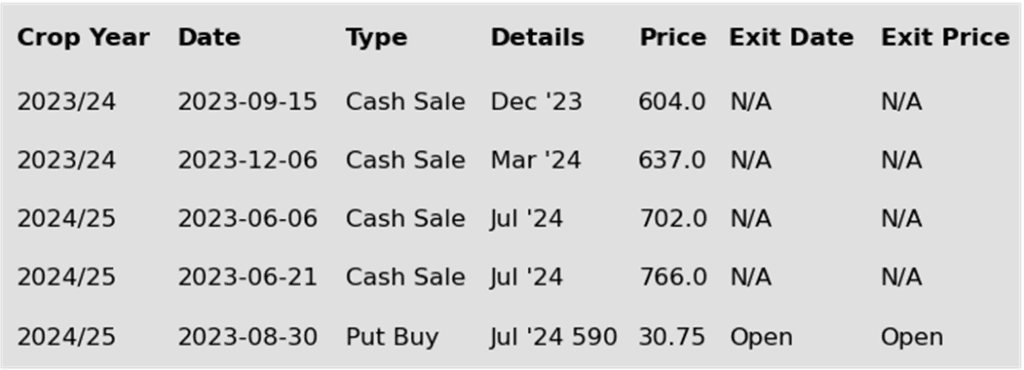

Above: So far, downside support near 555 continues to hold. Funds also continue to hold a significant net short position in Chicago wheat, that could press prices higher into the 584 – 618 resistance area if they choose to cover. If prices continue above that, the next major resistance level may come in around 635 – 650. Otherwise, if they turn back lower, major support below 555 may come in around 540.
KC Wheat Action Plan Summary
- No new action is recommended for 2023 KC wheat crop. Since December’s brief runup, prices have continued to erode as US exports continue to suffer from lower world export prices. Although fundamentals remain weak, considering the market is at levels not seen since spring of 2021, and funds continue to hold a considerable net short position, these factors could trigger a return to higher prices if any unforeseen risks enter the market. Grain Market Insider’s strategy is to look for price appreciation as weather becomes a more prominent market mover and may consider suggesting additional sales if prices make a modest 20% retracement of the 2022 highs back toward 700.
- No new action is recommended for 2024 KC wheat. Since the beginning of the year, the July ’24 contract has been in a downtrend alongside the front month contracts, while also setting new contract lows and becoming very oversold. During this time, managed funds have maintained a net short position in the front month of around 35,000 contracts. While this net short position is about 15,000 contracts smaller than it was at the end of November, it is still large enough to trigger a short covering rally, much like the one that began in late November, and could easily translate to higher prices for July ’24 as well as the front months. Back in August, Grain Market Insider recommended buying July ’24 KC wheat 660 puts to protect the downside, and as the market got further extended into oversold territory, Grain Market Insider recommended exiting 75% of the originally recommended position. Recently, Grain Market Insider also recommended exiting the remaining 660 puts to protect any gains that have been made. Considering bullish headwinds remain, and the equity gained from the closed July 660 put position, Grain Market Insider is prepared to consider recommending additional sales for the 2024 crop if July ‘24 retraces back toward the January highs in the mid-640s.
- No action is currently recommended for 2025 KC Wheat. Grain Market Insider isn’t considering any recommendations at this time for the 2025 crop that will be planted next fall. It may be late spring or summer before Grain Market Insider starts considering the first sales targets.
To date, Grain Market Insider has issued the following KC recommendations:


Above: May KC wheat is correcting from being oversold as it consolidates after making a 556 ¾ low on Feb. 16, with nearby resistance just overhead between 590 and 600. So far, this support level is holding, and if prices break out to the upside, further resistance may come in around 610. If they break out to the downside, then the next major support area may be found around 530.
Mpls Wheat Action Plan Summary
- No new action is currently recommended for 2023 Minneapolis wheat. Since last summer, front month Minneapolis wheat has slowly stair-stepped lower with weaker world prices and little bullish news to move markets higher. During this time, the 50-day moving average has acted as resistance, above which the market has not been able to hold for very long. Managed funds have also established and maintained a record (or near record) short position for much of the same time. Although bullish headwinds remain, the market has become very oversold, and the large fund net short position continues to leave the market susceptible to a short-covering rally at any time here. Grain Market Insider’s strategy is to look for a modest retracement of the July high and consider additional sales in the neighborhood of 675 – 700.
- No new action is recommended for 2024 Minneapolis wheat. Much like the front month contracts, Sep ’24 has been in a downward trend since last summer. And just as Sep ’24 has been influenced to the downside by the front months, it could be similarly influenced to the upside by the front months if a bullish impetus enters the scene and triggers an extended short covering rally due to the fund’s large short position. Back in August, Grain Market Insider recommended buying July ’24 KC wheat 660 puts to protect the downside (due to their higher liquidity and correlation to Minneapolis), and as the market got further extended into oversold territory, Grain Market Insider recommended exiting 75% of the originally recommended position. Recently, Grain Market Insider recommended exiting the remaining 660 puts to protect the gains that have been made. From here, Grain Market Insider is prepared to consider recommending additional sales for the 2024 crop if Sep ‘24 posts a modest 22% retracement back toward the 2022 highs of 1400.
- No action is currently recommended for the 2025 Minneapolis wheat crop. Grain Market Insider isn’t considering any recommendations at this time for the 2025 crop that will be planted in the spring of next year. It may be late spring or summer before Grain Market Insider starts considering the first sales targets.
To date, Grain Market Insider has issued the following Minneapolis wheat recommendations:
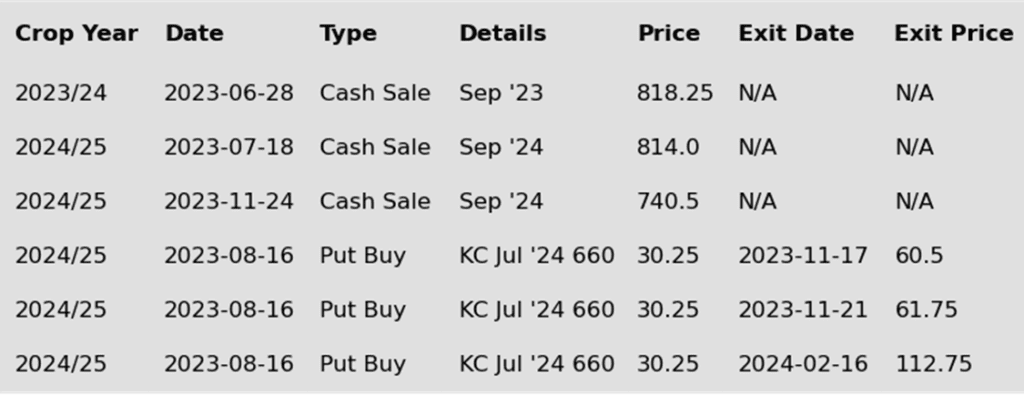

Above: May Minneapolis wheat appears to be consolidating after posting a bullish reversal on February 26. If prices continue higher, they may run into resistance around 675 – 680. If prices turn back lower, the next major support level below 640 may come in near 600.
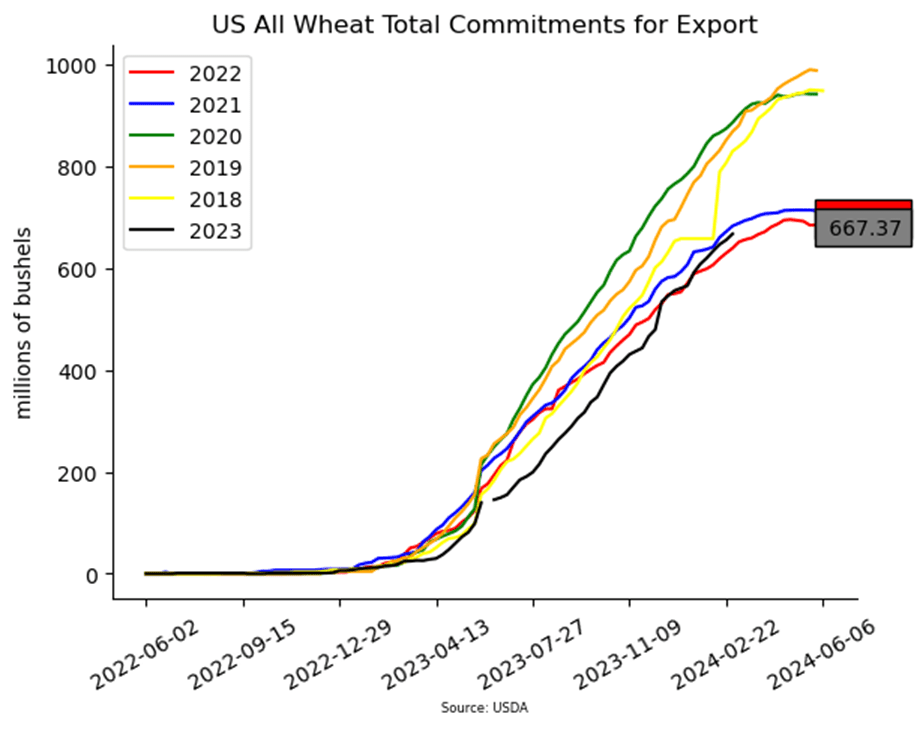
Other Charts / Weather
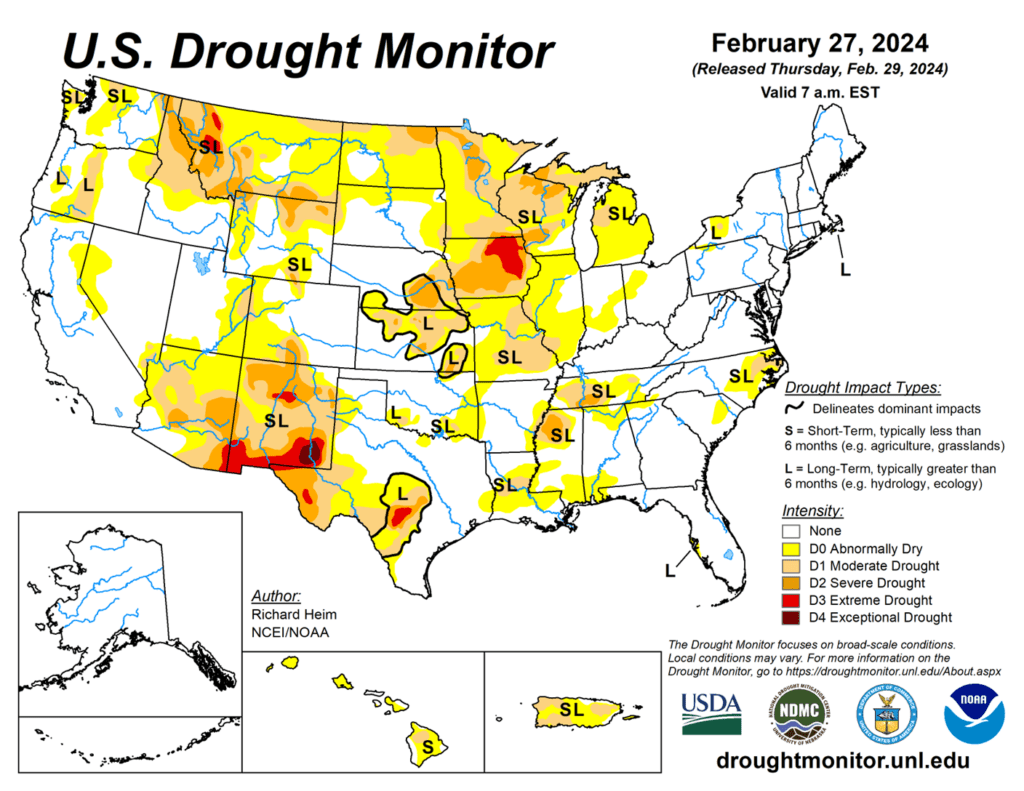
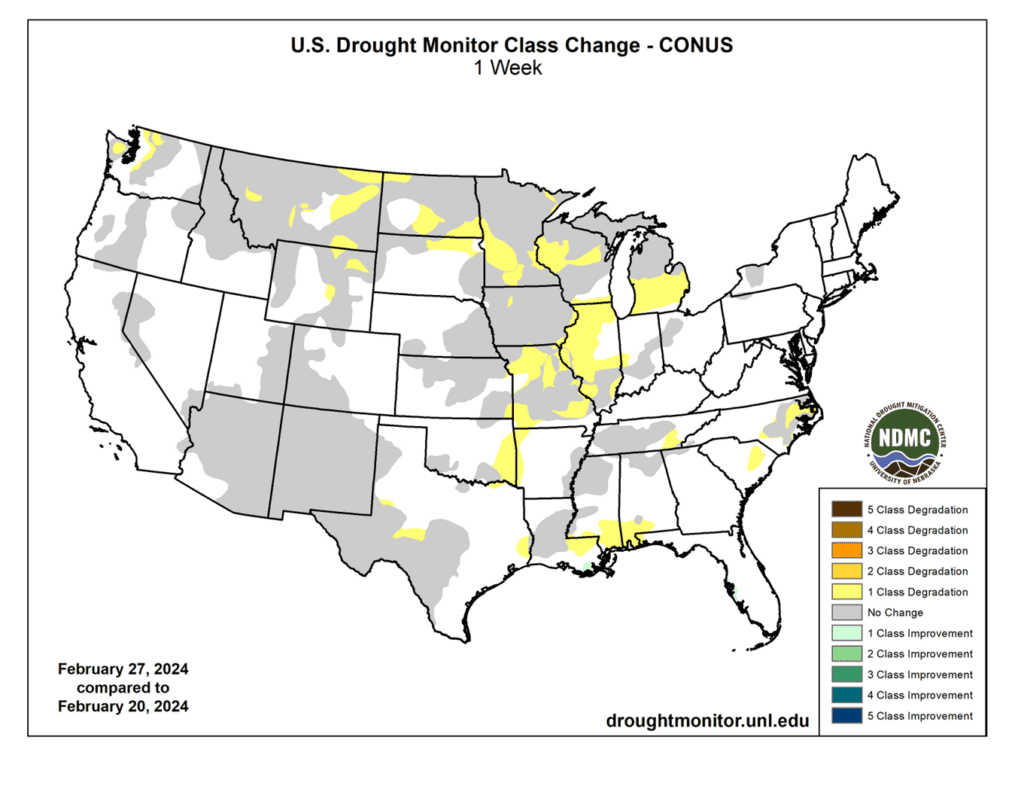
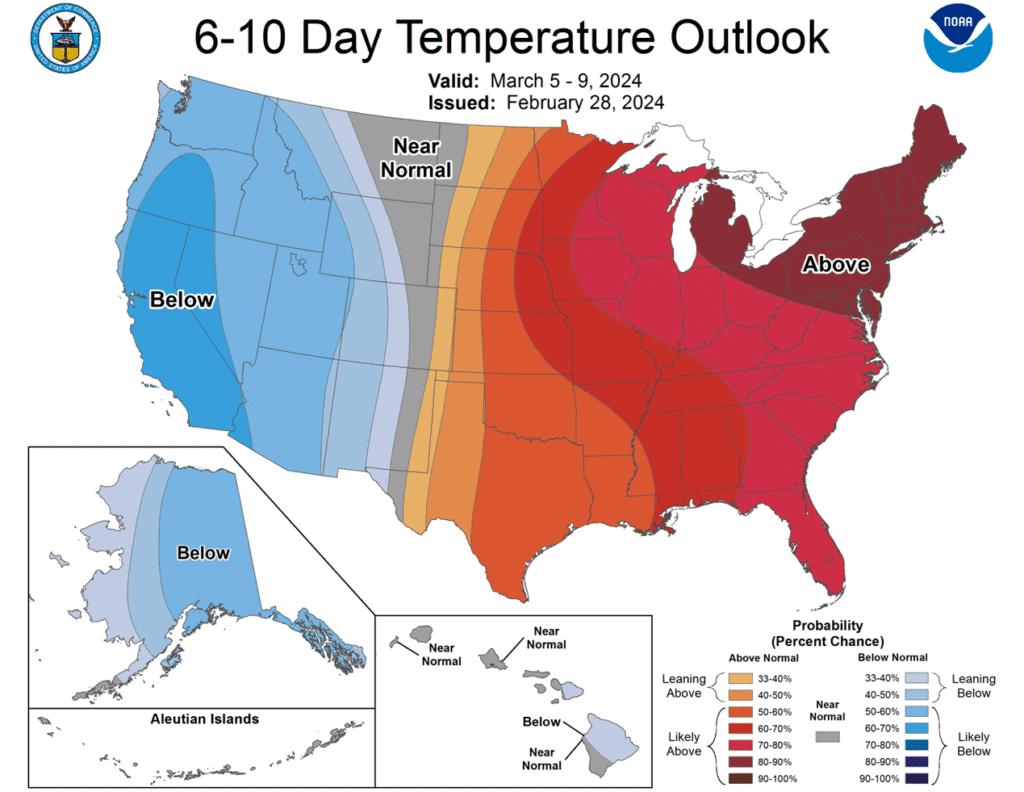
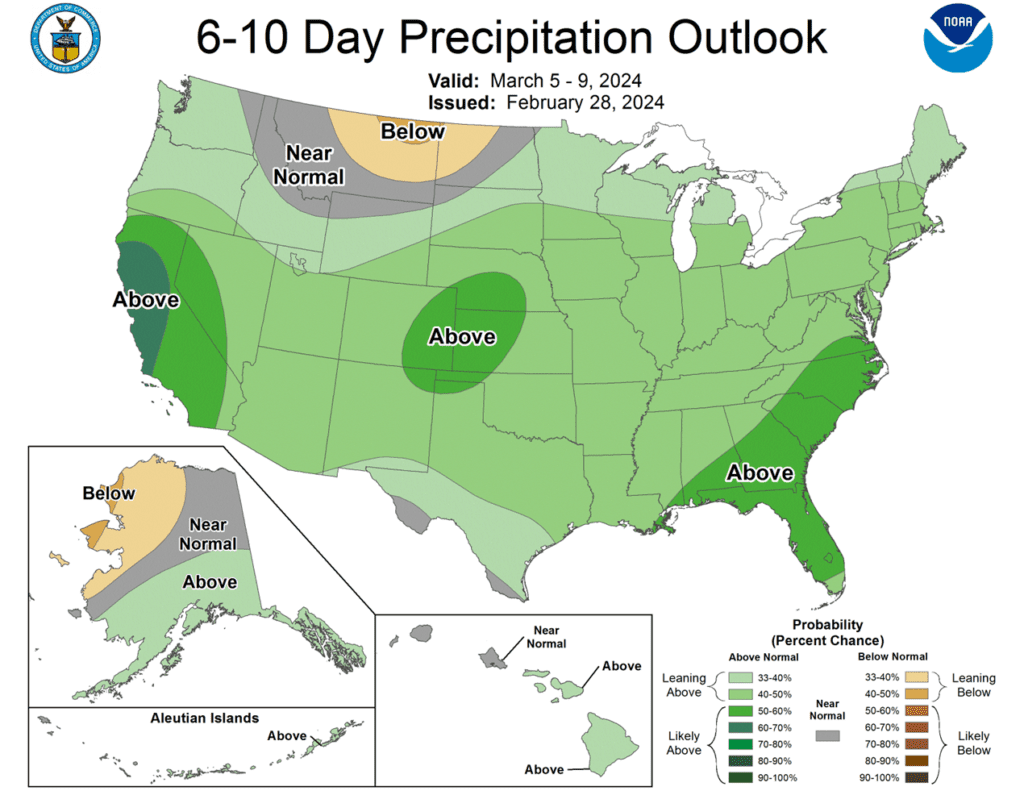

Above: Brazil 2-week forecast precipitation, percent of normal, courtesy of the National Weather Service, Climate Prediction Center.















